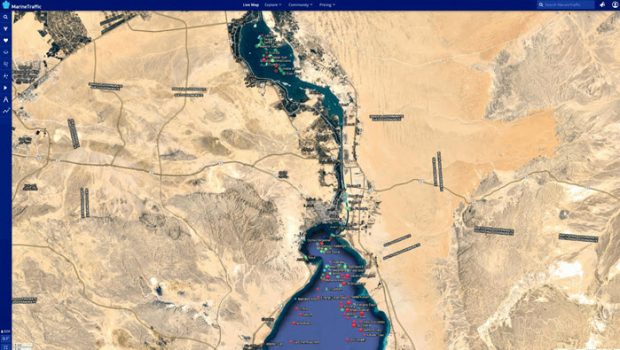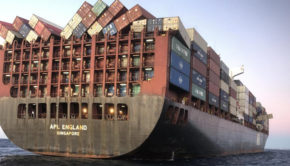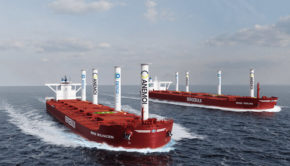Latest chapter in the Suez Canal story
Published on April 1st, 2021
If you didn’t know much about how containers move around the world, there was a recent education about the importance of the Suez Canal when one of the largest ships in the world, Ever Given, blocked the passage from March 23 to 29.
The ship was passing north through the Suez Canal on its way to Rotterdam from Tanjung Pelepas when it became stuck near the village of Manshiyet Rugola, running aground diagonally after losing the ability to steer amid high winds and a dust storm. The ship ended up with its bow wedged in one bank of the canal and stern nearly touching the other.
Allowing the world to witness the accident was MarineTraffic, the leading maritime information service which provides real-time vessel tracking based on AIS data. In this report, Alex Wood describes this latest chapter in the Suez Canal story:
Tug boats, which had been so instrumental in moving the vessel, honked their horns triumphantly as the 400m-long container ship was dislodged with the help of dredgers.
Ships can now make their way through the waterway, but the incident could have big ramifications for weeks to come. Even once the backlog is cleared – hopefully within the next few days – the impact on shipping markets won’t just disappear.
Maersk believe the “ripple effects on global capacity and equipment” were significant.
“There’ll be an investigation, clearly, because this has had such a big impact and exactly what’s happened here, I think, will be debated for some time,” Marcus Baker, global head of marine and cargo at Marsh Inc, told Reuters.
“What do we do going forward to ensure it doesn’t happen again? Again, I would leave that to the competent authorities that are in Egypt to decide how they want to make sure that traffic transits safely through the canal because, look, it’s in their interest to do that.”
The peculiar episode once again shone a light on the importance of the Suez Canal.
The waterway was originally constructed by the Suez Canal Company between 1859 and 1869. However, its origins go back as far as Ancient Egypt and the goal was always the same – to open up global trade between the east and west.
Pharaoh Senusret III is thought to have built a precursor connecting the Red Sea with the Nile River in 1850 BC. And Pharaoh Necho II (610-595 BC) had similar lofty ambitions – but it was the Persian conqueror Darius (522-486 BC) who made the dream a reality.
It was restored by Ptolemy II Philadelphus approximately 300 years later, although its use wasn’t to last. The gradual receding of the Red Sea, along with accumulations of silt from the Nile, meant the waterway fell into disuse.
Venetian traders were keen on the idea of a passage to India in the early 16th century. Napoleon Bonaparte, meanwhile, was also weighing up options following his conquest of Egypt in 1798.
The French commander couldn’t get his plans off the ground, though. He was informed that the Red Sea lay 30-feet higher than the Mediterranean, which would have meant the Nile Delta faced flooding. However, it turned out his engineers had got their calculations all wrong.
Paul-Adrien Bourdaloue, Robert Stephenson and Alois Negrelli took another look at the proposition in 1847. Ferdinand de Lesseps was then able to negotiate an agreement with the Egyptian viceroy. The Suez Canal Company was subsequently formed in 1854.
After work started on the project three years later, seventy-five million cubic metres of sand would ultimately be moved during the 10-year construction. The Suez Canal was formally opened to much fanfare in 1869.
The Canal became a symbol of British decline after the World War II after Gamal Abdel Nasser nationalised it on 26 July 1956.
Forces from Britain, France and Israel forces advanced into Egypt on 29 October to regain control. The move, however, received widespread condemnation from the international community. The then British prime minister, Anthony Eden, was forced to order a retreat and eventually resigned.
The Canal would next become a focus during the Six Day War in 1967. As hostilities broke out between Egypt and Israel, 14 foreign cargo ships that happened to be in transit were told to drop anchor and await further instructions. They subsequently remained there for eight years!
“We were in a very comfortable prison,” Captain Miroslaw Proskurnicki of the Polish ship Jakarta told the New York Times. “The first month was like a holiday. The second month was very hard. By the end of the third month, it was terrible.”
The vessels became known as the ‘Yellow Fleet’, in reference to the colour of the sand that would accumulate on them.
What happens now the Ever Given has moved? Ships were traveling southwards towards the Red Sea. Canal services provider Leth Agencies say vessels have also resumed transit north from the Great Bitter Lake. However, some ships had already left the region, opting to take the longer route round the southern tip of Africa.
The Ever Given itself has received a full inspection at the Great Bitter Lake. There have been no reports of pollution or cargo damage and initial investigations last week ruled out any mechanical or engine failure.









 We’ll keep your information safe.
We’ll keep your information safe.